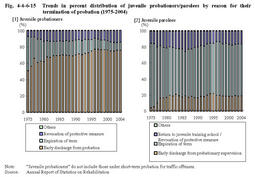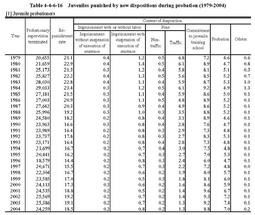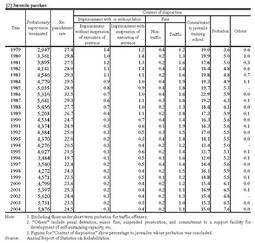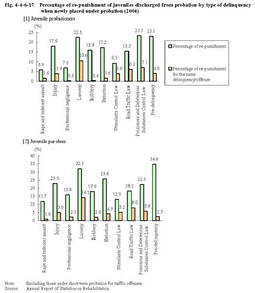| Previous Next Index Image Index Year Selection | |
|
|
3 Reasons for termination of probationary supervision and percentage of re-punishment Fig.4-4-6-15 shows the percent distribution of juvenile probationers/parolees for their termination of probation over the last30years,by reason.
As for juvenile probationers,the percentage of those who are granted early discharge from probation has been on a rise,accounting for about three-quarters(75.7%)in2004. Good-conduct measures(temporary suspension of probation)were taken for59juvenile probationers,and notification to family court was implemented for30juvenile probationers(Source:The Rehabilitation Bureau,Ministry of Justice). As for juvenile parolees,19.0%were granted early discharge from parole,64.2%completed the term,and16.5%were returned to juvenile training school(a juvenile is returned to juvenile training school by a decision of a family court in response to a proposal from the director of a probation office and a request from a Regional Parole Board)or received revocation of protective measures(former treatment is revoked because a juvenile is placed under new treatment due to repeating delinquency or offense).There have been no significant changes in these percentages.In2004,10juveniles were returned to juvenile training school(Source:Annual Report of Statistics on Rehabilitation). Fig.4-4-6-15 Trends in percent distribution of juvenile probationers/parolees by reason for their termination of probation(1975-2004) (2) Percentage of re-punishment Table4-4-6-16 shows the percentage of those juvenile probationers/parolees who were punished again by new protective measures(excluding return to juvenile training school)or by criminal dispositions due to repeating crimes or delinquent acts during their probation among those whose probation was concluded,since1979.
Table4-4-6-16 Juveniles punished by new dispositions during probation(1979-2004) Fig.4-4-6-17 shows the percentage of re-punishment of juvenile probationers/parolees discharged from probation by type of delinquency when they were newly placed under probation.Fig.4-4-6-17 Percentage of re-punishment of juveniles discharged from probation by type of delinquency when newly placed under probation(2004) |



